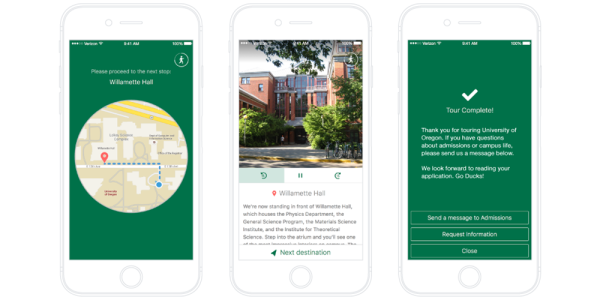Will a virtual campus tour work?
(Editor’s Note: Curious about how your Admissions team can use mobile tech in their recruitment strategies? View our free, on-demand webinar to hear how the University of Oregon is using a mobile app to up its game.)
Schools are adding a virtual campus tour to their recruitment arsenal – but how does it fit into the larger communication picture?
It’s widely known that campus tours are major decision-makers when it comes to prospective students and their college search process. In fact, independent research has confirmed that tours are the the number one most influential factor when it comes to making the big decision.
Campus tours work because they’re tangible and students are able to form a personal, visceral connection to a campus by experiencing it firsthand. There doesn’t seem to be a replacement for an in-person guided walking tour with an authentic student. But as Admissions teams strive to incorporate new media and technology into their communication strategies – and vendors continue to innovate communication platforms – is there any merit to a virtual campus tour experience? Can technology provide the “real campus experience”?
In short, yes it can. As long as the technology you’re implementing is supporting the gold standard recruitment tool – an in-person walking tour of campus – and not replacing it. Let’s unpack what that means for your strategy.

Guidebook’s mobile virtual campus tour
What can digital do?
If campus tours are so effective, do we need to provide a digitally-enhanced virtual campus tour? It doesn’t seem like there’s much to improve upon. This is where it’s time to think beyond a virtual campus tour that stands in for an in-person tour and conceive of how a virtual tour experience can enhance or supplement your current offering.
75% of high school seniors say they’ve toured a campus on their own without the aid of a guide.
A tour for everyone
Not every student who is interested in your school is taking a tour led by your Admissions office. In fact, 75% of high school seniors say they’ve toured a campus on their own without the aid of a guide. It may be surprising, but that could equate to thousands of students taking an unaccompanied tour of your campus each year – with no context other than what they can see on their own.
A mobile virtual campus tour could easily capture all the students who are going to explore your campus on a weekend, holiday, or otherwise without a campus tour guide. They may not get that extra-personal perspective, but at least they get your messaging right on their smartphone as they walk campus.
Reduce brain drain
Each student will have their own style when it comes to retaining information from your campus tour. We can all agree, however, that campus tours come with a lot of overwhelming details and that when it comes time for students to make a decision we want them to be able to look back on their tour positively.
A virtual campus tour can allow a student to come back to their tour experience and remember particulars without needing to take copious notes in the moment. The mobile tour then serves as a digital archive of their experience.
Appeal to changing sensibilities
Incoming freshman are part of a generation that grew up with the internet – and even moreso now with the ubiquity of mobile devices. For them, you can expect a campus tour experience to include mobile media with or without your encouragement. Your tour will be Instagrammed, Snapchatted, and the like.
A virtual campus tour available on your prospective students’ devices can not only integrate their media sensibilities, but provide a context that makes them relevant. Delivering a virtual tour in a mobile format also goes a long way towards meeting students where they are – and that’s on their devices.
The context for digital communication
The bottom line is that nothing will ever replace your in-person tour. But that doesn’t mean that it can’t benefit from the new digital tools that are constantly being developed. Here’s the trick – think about your various digital communication efforts as individual pieces within your Admissions communication pie.
A website, social media networks, a mobile app, a virtual campus tour – these are all communication channels that are available to you. It can be easy to get caught up in the individual strategy for each one of those channels, but as long as the message is consistently supporting the one channel that matters – your in-person tour – you’re unlikely to steer yourself in the wrong direction.
Santa Clara University in California has recently chosen to complement their tour offerings with a mobile virtual campus tour. Grace Hartman, Senior Associate Director of Admission, says that although they had provided a virtual tour and paper self-guided tours in the past, they chose to introduce a mobile tour into their communication mix. “It also allows us to more fluidly change our information, update facts, add new stops as construction on campus is completed, and add tours in multiple languages as our visitor demographic continues to change.”
“It allows the true student experience to still come through.” -Grace Hartman, Senior Associate Director of Admission, Santa Clara University
Is a virtual tour necessary?
There’s obviously a place for digital communication within your larger communication strategy, but how does a virtual campus tour rank in terms of necessity? Will you see return on the things that matter most – capturing students who don’t end up taking your curated tour, and increasing tour numbers (and thereby applicants)?
As mentioned before, it’s possible there are hundreds – if not thousands – of students touring your campus and not receiving your official, curated message. At the very least, a supporting virtual campus tour is able to accompany those students as they explore your campus at their own pace, all while retaining the narrative that you’ve constructed for your student-led tour. But beyond the advantage of reaching those otherwise unreachable students, you’re actually extending the life of the tour itself.
The virtual campus tour, if marketed correctly, can become part of a strategy that encompasses a before, during, and after mindset. Because prospects can download the tour on their personal devices, the content is available to them while they’re preparing to visit, while they’re interacting with your campus, and then as they move into a decision phase after the tour is done and they’ve left your campus.
The virtual campus tour verdict
We’ve invested a lot in our student-led tours and our student ambassadors with good reason. So how does a virtual product fit in without undermining those investments? The bottom line is that, in order to reap the benefits of a virtual campus tour, it needs to be mobile, it needs to carry the through line of your existing recruitment message, and it needs to complement your existing live tour.
When considering your larger communication strategy, make sure to consider digital communication as a useful piece of the overall strategy and not a separate entity. You’ll find you’re not only reaching more students, but that your message is continuing to resonate long after they’ve left your campus.
Want to create a self guided mobile tour for your campus? Reach and track more prospects with a virtual campus tour today. You can get started building one for free with Guidebook’s Campus Tour template or speak with a higher education expert on how you can start offering this exciting communication tool.



